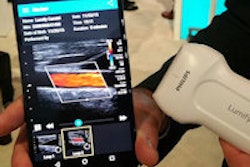
CHICAGO - Online check-in for flights has been a real time-saver for travelers; a similar concept for MRI exams could improve patient satisfaction and save thousands of dollars for radiology departments, according to research presented at the 2015 RSNA meeting.
By letting patients fill out online safety questionnaires on a patient portal prior to their MRI appointments, a team from UT Southwestern Medical Center significantly reduced the types of large delays that can occur during traditional safety screening performed at the time of the appointment. The resulting staff overtime savings could reach more than $20,000 per year if all patients participated in online screening, the researchers estimated.
"An online MRI screening system is effective in the reduction of delays, patient turnaround time, and costs," said Dr. Ali Pirasteh. He shared the research, which was awarded the Trainee Research Prize - Resident, during a scientific presentation on Tuesday afternoon.
Screening patients before MRI is mandatory for safety reasons. However, the screening process is also designed according to the needs of the medical center, and it is often inconvenient for the patients. Patients are typically asked to fill out a paper questionnaire after they show up at the appointment, or they receive a phone call before the appointment when they might not have their medical information in hand, Pirasteh said.
"This can lead to inadequate information collection and compliance with patient safety, as well as delays, cancellations, and increased cost," he said.
Online patient screening
A patient-centered screening process that provides online check-in prior to MRI and allows patients to fill out forms ahead of time would be convenient, improve the quality and amount of information collected, improve efficiency, and decrease cost, according to Pirasteh.
At UT Southwestern, patients can use the institution's MyChart online patient portal to confirm appointments and communicate with providers via email. In a 2014 initiative, the institution's radiology department worked with the electronic medical record (EMR) vendor Epic Systems and the MyChart team to add a link in the portal to an online screening questionnaire.
Patient answers to these questionnaires are exported into the EMR. Prior to the patient's appointment, the MRI technologist reviews the information and then contacts the patient if there are any items that need to be clarified.
"If there is any verification or safety information that needs to be addressed, it is addressed before the patient comes to the appointment via an email or a phone call," he said.
Those patients who don't complete the online questionnaire have their appointments confirmed over the phone or by voicemail. After all patients check in at the front desk for their appointment, they are interviewed and screened. If applicable, they also receive an IV placement before entering the magnet room for the study.
Following implementation of this online screening process, the researchers evaluated its effect for a six-week period, including recording whether or not patients utilized the online screening system. They also calculated the time from the beginning of the interview/screening process until when the patient was cleared to enter the magnet. The team also noted any reason for the delay. Patients were excluded from the analysis if they were same-day add-on appointments, if they were research cases, or if they had incomplete forms.
Of the 773 patients included in the study, 200 (26%) participated in the online screening process, while 573 (74%) did not. The group of patients who performed online screening went through the interview/screening process faster than those who didn't.
For online screening, the mean interview/screening duration was 12 minutes (range, 2-43 minutes), compared with 14.1 minutes (range, 2-132 minutes) for traditional screening. The difference was statistically significant (p < 0.05).
Outlier effect
"Two minutes might not seem like much, but there are many more outliers -- people who take way longer -- in the traditional screening group compared to the online screening group," Pirasteh said. "Essentially, online screening was able to eliminate those [outlier] patients."
In looking closer at significant delays, 13 patients in the traditional screening group had delays that were potentially preventable by utilization of the online screening system. This included five patients with port access, three with vascular stents, two with vascular stents and aneurysm coils, two with a low glomerular filtration rate requiring radiologist clearance, and one with a programmable ventriculoperitoneal (VP) shunt. One patient who had participated in online screening had a preventable delay due to a history of an MRI contrast reaction. There were 14 other delays that could not have been prevented via online screening.
After adjusting for the different prevalence of potential causes of delay, the researchers found that the average interview/screening process was two minutes shorter in the online screening group, a statistically significant difference (p = 0.03). There was no significant difference in duration of the median interview/screening process among the two patient groups; this illustrates the impact of outliers that cause the extreme delays, Pirasteh said.
These delays can have a cascading effect that last through the end of the day, leading to overtime for MR technologists and other staff to complete the daily work, according to Pirasteh.
Cost savings
The researchers estimated annual technologist overtime labor savings of $5,109 from online screening if 25% of patients used the online screening process. If 100% of patients participated, savings would reach $20,709, according to the group. These estimates are based on the assumption that online screening saves two minutes per patient, the outpatient MRI center has two MRI scanners being operated by one technologist each for five days a week, and the outpatient schedule has 40 patients a day.
Pirasteh noted limitations of the study, including the lack of a comparison cohort for implementing the online screening system and a utilization rate of online screening that's highly dependent on the patient population. In addition, savings could be overestimated in centers that do not operate at full capacity, he said.




















